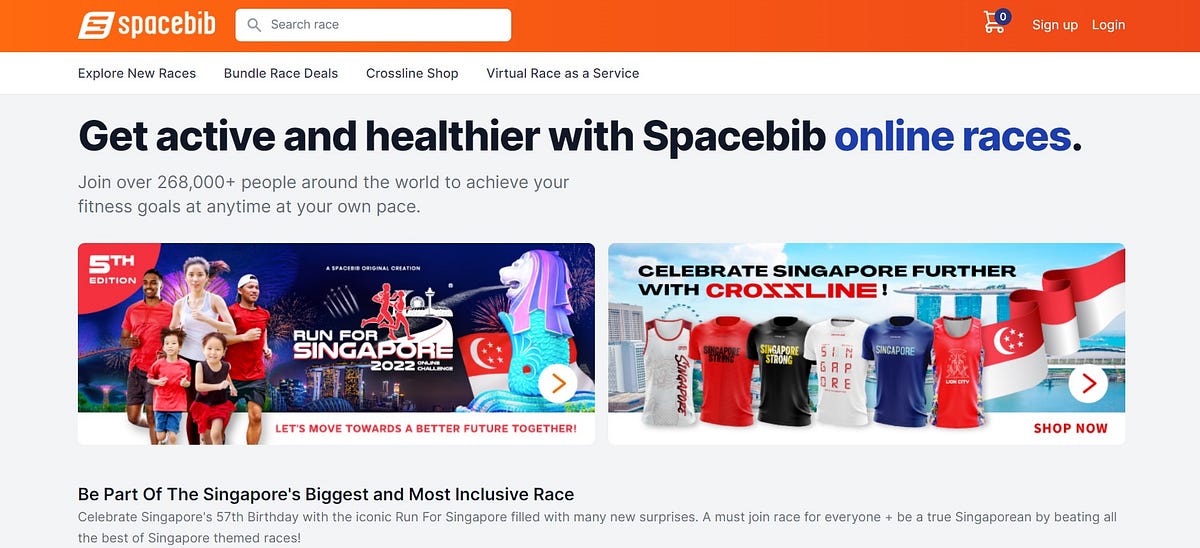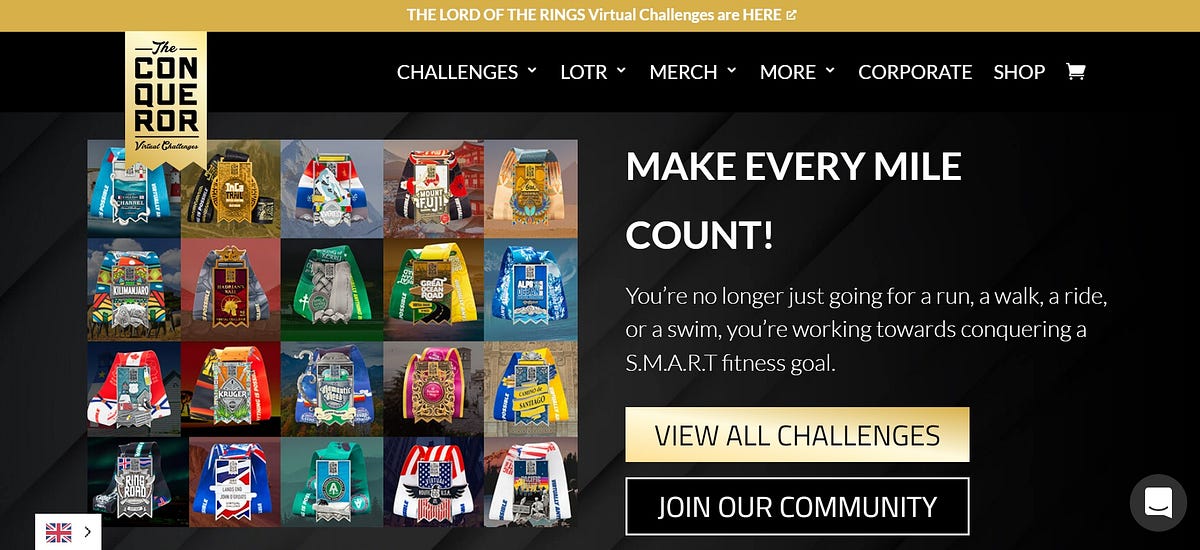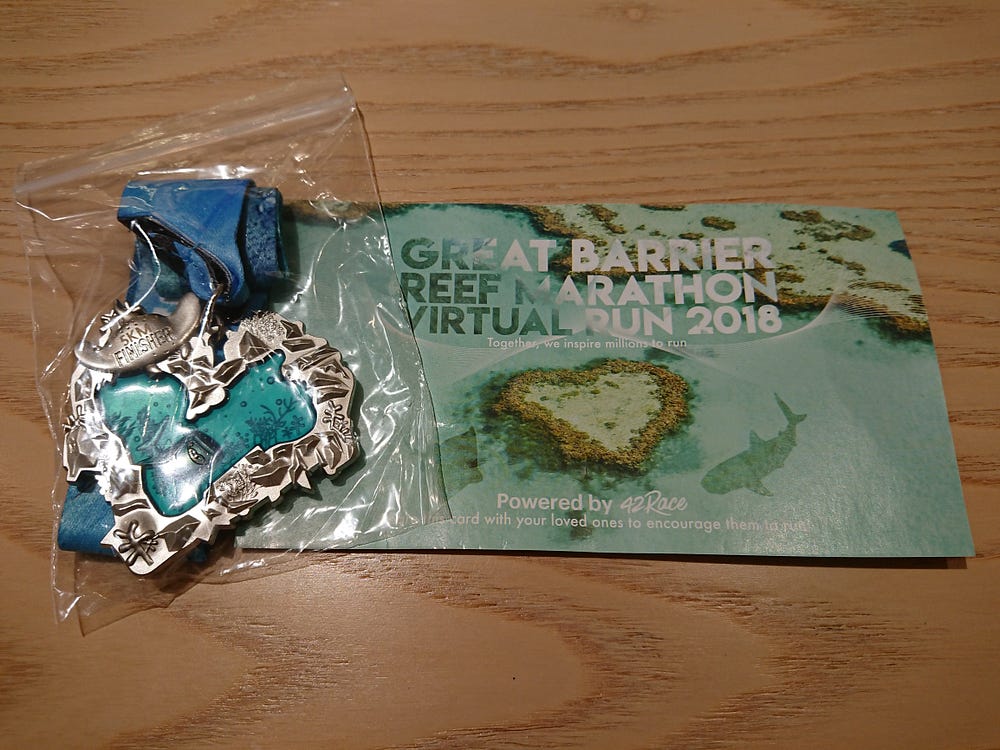
As mentioned in my previous article about how I got started with virtual runs, I have tried various platforms since 2018 which can range from the event providers to those offering a list of events you can sign up for. Of course, what works for me may not be to your liking so do consider the pros and cons based on my experience with them before choosing the platform which would likely suit your needs.
For those who may be considering your options before taking your first step, do note that the platforms mentioned below may not ship the race/run entitlements to your location and that shipping charges will vary according to your delivery address. As such, it is recommended that you check the FAQs and conditions before signing up.
Without further ado, let’s get started!

42Race was the very first virtual run platform I used back in 2018. Other than it being featured in the article I read on this topic, the fact that it was based in Singapore, offered free shipping of its medals to local addresses and the race cost being SGD 9.90 each were the reasons why I decided to give this a shot. Since this was unchartered territory for me then, I had to find a platform which was relatively risk-free especially as I was worried about whether the medals would be delivered properly or the race charges would get too high due to foreign currency conversion rate fluctuations.
To get started, you can download the app either from Google Play or App Store and sign up for an account. Depending on the type of virtual event you sign up for, the upload method for your activities will differ.
When I first started, there were only virtual run events but as of now, there are also cycling and walking events. Running and cycling events are distance-based while walking events are steps-based. Most of the events organised in the past were designed by 42Race itself and either featured various themes like Chinese zodiac signs, astrological signs, round-the-world tours or were on key occasions within the year like Chinese New Year, Christmas, Mother’s Day, Father’s Day and Mid-Autumn Festival. If you signed up before a particular deadline, you could get your name engraved on the medal for free. I do not know if this engraving service is still applicable now considering that I haven’t signed up for a paid race in the past year. Delivery of the race premiums within Singapore is generally free unless otherwise stated. For other locations, you will have to check the app for more details.
Nowadays, there is a lot more variation in the types of events organised. There are those in partnership with sport-related companies such as Pocari Sweat and Asics, with shopping centres like Suntec City and Changi City Point that are actually geolocation games where you have to scan QR codes to complete missions and with charitable organisations, universities and government bodies.
For a distance-based running event, you can link the following apps to 42Race so that the distances can be uploaded automatically to your activity. Although the events are termed as “running” ones, you can also upload walking activities and they will count towards the accumulated distance for the event:
- Adidas Runtastic
- Apple Fitness
- Endomondo
- Fitbit
- Garmin Connect
- MapMyRun
- MiFit
- Nike Running Club
- Runkeeper
- Strava
For a distance-based cycling event, only Garmin Connect, Map My Ride, Runtastic and Strava can be used to clock the distances and upload to the app.
For a steps-based walking event, only Apple Health for iOS and Google Fit for Android can be used. As such, I have to connect my Garmin Connect to Google Fit through an app like Health Sync so that my steps can be uploaded automatically.
Actually, when I first started on 42Race, my biggest grouse was that it did not acknowledge the distances clocked on my Fitbit and I had to use Strava instead. And since there wasn’t any automatic syncing, I had to do a screenshot of my activity and upload that manually to the app which honestly speaking, was a big hassle.
For now, the idea of “automatic” doesn’t really seem so based on my experience thus far. In my case, I get prompted to upload my walking and running activity from Garmin to the 42Race app so I have to do a couple of additional clicks to complete the process manually. On the other hand, the steps clocked from Garmin and sent to Google Fit do get synced automatically once I refresh the app.
One thing I’ve noticed is that, the race costs have gone up — which is perfectly normal as inflation sets in over the years and the quality of the medals has somewhat improved. And to be fair, some of these races which are charging anything from SGD 10 to SGD 30 or more, do have premiums other than the medals. Personally, I don’t need the race T-shirts nor the sports water bottles so I tend to skip such events which are more expensive.
On the other hand, the number of free events where you don’t have to fork out anything and get a digital medal in return has increased. As such, if you don’t want or need to have a physical medal but still wish to take part in a virtual run or the cost is a concern (especially if you are doing multiple events), these free events will be ideal for you.
The platform is generally easy to use, save for the occasional hiccup when it keeps logging me out. The process of signing up for events and registering my activities is also pretty straightforward. However, there was a period of time when I stopped using this platform for a while because I was really frustrated with the quality of the medals. One particular episode was that the engraving on the medals were either misaligned or incorrect and it took a while before the issue was sorted out. No doubt there was no cost incurred on my part because shipping was free, it was quite frustrating to sort out the issue.
Since I sign up mostly for the free races these days, I don’t know how things are now with regard to the quality of the medals and delivery process. However, I think that the premiums directly issued by the organisations and companies are generally fine.

Spacebib, just like 42Race, was established in 2016 and based in Singapore. As I was looking for other platforms to sign up for virtual runs, I came across this and was likewise attracted to it because of the fact that there’s free shipping in Singapore and the prices seemed reasonable then, albeit slightly more expensive than 42Race at times.
There are in-house themes designed by Spacebib as well as collaboration races with some organisations or for special occasions. There is actually no auto syncing as far as I am aware since I always have to upload my Strava activity screenshots to the platform. You can either use the website or the apps which can be downloaded from App Store or Google Play. Compared to 42Race, the type of apps you can use to capture your run or walk activity is more varied as described in Spacebib’s FAQ:
Free running apps can be downloaded at the Google Play and Apple App Store. Some recommended apps are MapMyRun, Runkeeper, Strava, Runtastic, Nike Run Club etc. As each app or tracker is different, a rule of thumb is that as long as your screenshot did capture the distance clocked and duration of your activity, it’s sufficient. GPS map is not mandatory.
One important thing to note is that the race prices will change with time so if you are the type who signs up as soon as an event is announced, you will get to sign up at the lowest entry rate. However, I sometimes do need to deliberate over whether I can make it during the race period or if there is any issue which may affect my ability to complete the distance. Unsurprisingly, this meant that I had to give up on some races which I was initially interested in because the prices went beyond what I was willing to pay.
Generally, the delivery process and the quality of the medals are quite satisfactory based on my experience so far. However, do note that for some events, they will only send the medals after the entire race has finished. As such, even if you complete the virtual run way before the deadline, you might have to wait for a while to get your premiums. On the other hand, items like race T-shirts are delivered before the race in some situations so you can wear them when clocking your distance for that event.
There was only once when I was not so happy about the medal for a particular race from Spacebib but that was actually my fault. I was expecting a “medal” but what came was a small coin-sized medal. That was when I went to check the dimensions of the medal and realised that it was smaller than what I usually got from other virtual runs. That experience made me wise up and since then, I always made sure that I checked the medal details before signing up for any event. Regardless of which platform you use, I would recommend that you check the details on the race premiums so that you know what exactly you are paying for and can manage your expectations.
In the past year or so, I haven’t participated much in Spacebib’s races since the Lunar New Year race earlier in Feb. With inflation in all aspects of life, it is understandable that the costs of the races will go up correspondingly but some being as expensive as more than SGD 30 per event is a big deterrent for me. Even for a no-frills option of getting a completion medal only, it will be at least SGD 15 or so. Considering the number of races I sign up for, I really do have to be quite discerning over which runs to sign up for.
Sometimes, the issue lies in finding a suitable option to sign up for e.g. the World Online Marathon Tour for Toronto & Vienna, there is no bundle option to get both medals only. When this happens, I just give up on the race. If you are fine with the prices and like the race premiums offered, Spacebib would be good because of its delivery process and quality of its merchandise. However, do be mindful of when you sign up so as to get the best deal and select the appropriate option to get what you want.
The Conqueror Virtual Challenges / My Virtual Mission


New Zealand-based The Conqueror Challenges is a platform which I started using since June 2020. In case you may be confused, the name My Virtual Mission tends to appear when you search for The Conqueror so please let me explain the relationship between the two.
The Conqueror is the company which organises the virtual challenges while My Virtual Mission is the platform where you submit your accumulated distance-based activities to the challenges and it also allows you to create your own or corporate distance-based challenge which can serve as motivation for employees, friends and family members to get active together. In the past, you would have to sign up for challenges on The Conqueror and upload your activities through My Virtual Mission. Now, there is an easier way out where you can just make use of The Conqueror’s app (App Store / Google Play) to do both the sign-up and automatic uploading of distances for your challenges. However, if you prefer to upload your distances on a computer, you will have to use the My Virtual Mission website. And as mentioned on their website, here are the apps and devices you can connect to for automatic uploading of your activities.
You can log distances using two methods: 1) Manually — Either on the web or via our iPhone and Android apps. Select your exercise type, add a distance and boom, you’re done. You can add a screenshot of your tracker if you wish but it is not required. 2) Automatically — Via the range of apps and devices that we connect with. Currently, we support: Apple Watch, Apple Health, Garmin, Fitbit, Adidas Running, Strava, Map My Run, Map My Ride, Map My Walk, Runkeeper.
There are some unique characteristics of this platform which caters to people of all ages and fitness levels:
- The ability to decide on how long you want to do this virtual run for — although the distance is usually preset except for the annual challenges which you can decide on at the beginning of the year, you can decide on the number of days needed to complete the entire distance depending on factors such as your schedule, fitness level and type of activity. For example, if an event is more than 1,000km and you are walking the entire distance, chances are that you would need more days to complete this as compared to someone who is cycling. Likewise, if you can only walk 1 or 2 km a day, you would need a longer time period to stretch out the distance and make it achievable. Even if you find that you are unlikely to reach the target by the preset number of days for whatever reason, you can still extend it as you wish. This may not be possible for the annual challenge though which runs on a calendar year basis.
- Non-distance-based activities can also be included — this is something probably relatively unheard of since most virtual run events require the distance, time spent or even a screenshot of your complete route to count as activities which qualify to be counted towards the target. For those who engage in exercises which are non-distance-based such as yoga and cross fit, you can include these into the event by using the conversion chart on their website. In places where the weather can get too hot or cold for outdoor activities, this will come in handy as steps clocked while walking around in your house or doing housework would still be counted as your activities.
- Team entries — if an event’s distance is way too much for you to handle on your own, you can get friends and families to join you in achieving the target together. Each of you would have to sign up separately for your individual medals/merchandise but whatever the group has chalked up will be added together and counted towards one distance goal. And I’m speaking from experience because I signed up for the 4,000km-long Pacific Crest Trail challenge and after 504 days, I am still 240km-shy of the goal!
- Merchandise galore — besides the usual T-shirts and vests for events, there are also mobile phone cases, mugs and even their unique hexagonal medal hangers for you to display the results of your hard work.
- Supportive virtual runners community — The Conqueror Community on Facebook can be a real morale booster. This is especially when you are having difficulty trying to reach your target or when the people around you try to discourage you by saying things like virtual runs are not real like physical marathons or that people are not doing the real work to get their medals. Hearing the stories of one another on their own fitness journeys and getting advice on how to stay active despite challenges like fitness, illness or injuries can be pretty inspiring and useful. As for the discouragement and negativity from people around you who might not see the value of virtual runs, being aware that you are not alone on your pursuit of fitness on your own terms is very assuring and liberating.
As I mentioned above, signing up with a foreign platform was something I wasn’t prepared to do due to various reasons. However, the experience I’ve had with The Conqueror so far has been amazing. Not only are the medals well-designed and of a high quality, features such as being able to see your actual location through Google Maps based on your completed distance so far lend a sense of reality to the virtual run as if you are physically there. Postcards sent virtually from designated landmarks help you to know more about the places you’ve “passed”. Last but not least, you can also do your part for the environment by reaching preset milestones that will allow you to choose planting a tree or stopping plastic bottles from entering the ocean.
As for the things you have to take note of, I would say that the cost and delivery time are what you have to consider. Given the quality of the medals and the overseas delivery, the cost per event is definitely pricier than the other Singapore-based platforms I am using. Coupled with the foreign exchange fluctuations, I do need to be more selective about the events to sign up for. In order to get the best deal, you should sign up for the challenges within the same week that they are announced since the prices will be at a discount. Sometimes, there are discount codes and promotions as well. And if you are just keen on the medals, make sure you select the correct option as the other choices come with premiums like the T-shirts and vests.
As for the delivery time, depending on where you are located and if there is a delay in shipping at your local postal services, it can take a bit of time for your items to reach you. Generally, if it’s not within the festive season, the medals will reach me in about 2–3 weeks after they are sent out from the US (as per the shipping label). There have been fellow runners who remark that the delivery time can take longer than this in some parts of Europe or the US though so do manage your expectations accordingly. Nonetheless, if it’s been more than a month since the notification about the shipment was sent to you, there is no harm contacting The Conqueror to see how they can help.
Now that you’ve read about these platforms, how about checking them out to see if any of them suits you? The hardest part in doing something is getting started so I hope that you find something which can help you begin your fitness journey for the sake of your health on your own terms.

